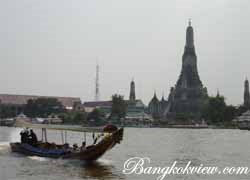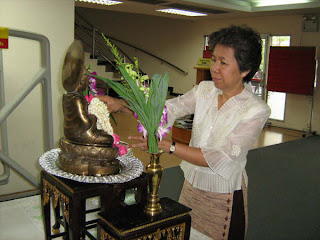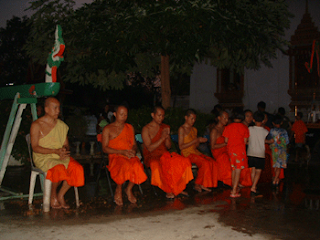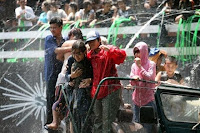BMCL Subway: BMCL Subway is another comfortable and fast transportation choice. The beginning of “Chalerm Ratcha Mongkhon” line is Hua Lum Phong station (also the main train station in Bangkok), total of 18 stations, major stations at: The Queen Sirikit's International Convention and Exhibition Center, Silom, Suan Lumpini, Asoke, Ratchada, Ladprao and Pahonyotin road. The Asoke and Silom stations are connected to the the BTS. There are also "Park & Ride" at Ladprao and Phra Ram 9 Stations. BMCL Subway has a minimum and maximum fare of 10-15 baht (For trial period only)The BMCL subway is open daily from 06.00 a.m. - 12.00 midnight. For more information, call: 0-2264-5200.

Tuk-Tuk: These three-wheeled 'open-air' motorised taxis are popular for short journeys. Fares must be bargained in advance. Minimum fares, for journeys of up to 3 kilometers, are approximately 30 baht.
 Boats: There are various types of boat identified in color flags. Boat service on the Chao Phraya River connects Bangkok with the northern neighbouring province of Nonthaburi, starting from the Tha Nam Non Pier and ending at Saphan Taksin Pier (Sathorn).Boat (no flag) stop at all pier, has a minimum fare of 8 baht.Rapid boat (orang flag) has a fare of 10 baht all routes.Express boat (yellow flag) stop at only on crowded and main piers. The Express boat has a fare of 15 baht all routes. After rush hour, these boat are used for tourist purpose. There are guide boats for travellrs with guide to give information about the riverside. The boat with blue flag, is the fastest stopping only on 3 pier, ThaNamNon Pier, Siriraj Pier and SaphanTaksin (Sathorn) Pier.It has a minimum and maximum fares from 25-35 baht. (For trial period, it just newly had this type)Boats run daily from 06.00 A.M-06.40 P.M.
Boats: There are various types of boat identified in color flags. Boat service on the Chao Phraya River connects Bangkok with the northern neighbouring province of Nonthaburi, starting from the Tha Nam Non Pier and ending at Saphan Taksin Pier (Sathorn).Boat (no flag) stop at all pier, has a minimum fare of 8 baht.Rapid boat (orang flag) has a fare of 10 baht all routes.Express boat (yellow flag) stop at only on crowded and main piers. The Express boat has a fare of 15 baht all routes. After rush hour, these boat are used for tourist purpose. There are guide boats for travellrs with guide to give information about the riverside. The boat with blue flag, is the fastest stopping only on 3 pier, ThaNamNon Pier, Siriraj Pier and SaphanTaksin (Sathorn) Pier.It has a minimum and maximum fares from 25-35 baht. (For trial period, it just newly had this type)Boats run daily from 06.00 A.M-06.40 P.M.
















 Activity schedule:
Activity schedule: 
